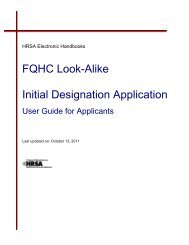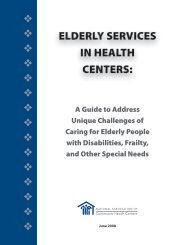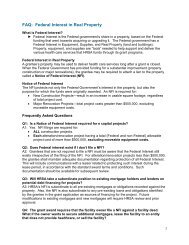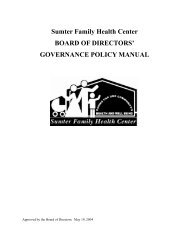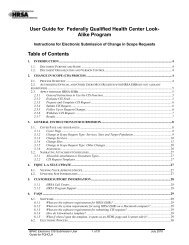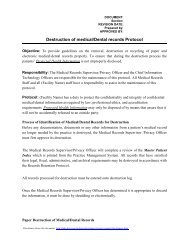Medicare/Medicaid/Other Payment - Bureau of Primary Health Care
Medicare/Medicaid/Other Payment - Bureau of Primary Health Care
Medicare/Medicaid/Other Payment - Bureau of Primary Health Care
You also want an ePaper? Increase the reach of your titles
YUMPU automatically turns print PDFs into web optimized ePapers that Google loves.
The BPHC Newly Funded TA Web Guide<br />
Resources for New and Existing Grantees<br />
Developed by:<br />
The U.S. Department <strong>of</strong> <strong>Health</strong> and Human Services (HHS)<br />
<strong>Health</strong> Resources and Services Administration (HRSA)<br />
<strong>Bureau</strong> <strong>of</strong> <strong>Primary</strong> <strong>Health</strong> <strong>Care</strong> (BPHC)<br />
Office <strong>of</strong> Training and Technical Assistance Coordination (OTTAC)<br />
The BPHC Newly Funded TA Web Guide is a self assessment tool designed to help new BPHC grantees provide<br />
high-quality primary health care from the day they open their doors for business. The Guide is a central<br />
hub for links to HRSA-approved templates, information pages, and policy documents, and many other<br />
resources. The intent <strong>of</strong> the Web Guide is to help <strong>Health</strong> Center grantees improve their quality and<br />
efficiency, work within <strong>Health</strong> Center Program Requirements, and access Federal policies, programs and<br />
resources intended for the specific needs <strong>of</strong> <strong>Health</strong> Centers.<br />
This document is a printable version <strong>of</strong> a portion <strong>of</strong> the content available on the Web Guide. It was<br />
developed by the BPHC Office <strong>of</strong> Training and Technical Assistance Coordination and is hosted at:<br />
http://bphc.hrsa.gov/technicalassistance/index.html
1b. <strong>Medicare</strong>/<strong>Medicaid</strong>/<strong>Other</strong> <strong>Payment</strong><br />
This section provides a brief overview <strong>of</strong> the steps needed to enable your health center to be<br />
reimbursed by <strong>Medicare</strong> and <strong>Medicaid</strong> under the FQHC payment system. Detailed information on this<br />
topic is available in PAL 2011-04, “Process for Becoming Eligible for <strong>Medicare</strong> Reimbursement under the<br />
FQHC Benefit.”<br />
<strong>Medicare</strong> and <strong>Medicaid</strong>’s Reimbursement System for FQHCs: Both <strong>Medicare</strong> and <strong>Medicaid</strong> have<br />
payment systems that are unique to Federally Qualified <strong>Health</strong> Centers (FQHCs.) These systems are<br />
designed to reflect the relatively higher intensity <strong>of</strong> health center patients and the broader range <strong>of</strong><br />
services that health centers provide. <strong>Payment</strong> is made on a per-visit basis, meaning that FQHCs receive<br />
a standardized, predetermined amount for each visit, regardless <strong>of</strong> which services were actually<br />
provided.<br />
Note that being approved for a health center grant through Section 330 or receiving a designation as a<br />
Look-Alike is not sufficient for a health center to be reimbursed under the FQHC payment system.<br />
Rather, a health center must apply to be enrolled in each program as an FQHC, and this application must<br />
be approved, before payment under the FQHC system begins. Under <strong>Medicare</strong> (and many State<br />
<strong>Medicaid</strong> programs,) payment as an FQHC is not retroactive to services provided prior to the date the<br />
application was approved. For these services, health centers may bill <strong>Medicare</strong> under the name <strong>of</strong><br />
individual providers, and will be reimbursed based on traditional payment systems (e.g., the physician<br />
fee schedule under <strong>Medicare</strong>.)<br />
Enrolling and Billing Under <strong>Medicare</strong><br />
How to prepare and submit a <strong>Medicare</strong> Enrollment Application: For information on how to prepare<br />
and where to submit a <strong>Medicare</strong> enrollment application, see PAL 2011-04, “Process for Becoming<br />
Eligible for <strong>Medicare</strong> Reimbursement under the FQHC Benefit.”<br />
Importance <strong>of</strong> prompt submission <strong>of</strong> <strong>Medicare</strong> enrollment application: Given that reimbursement<br />
under the <strong>Medicare</strong> FQHC system does not begin until the date the enrollment application is approved,<br />
health centers are strongly advised to submit this application as soon as possible and to remain in<br />
regular contact with the <strong>Medicare</strong> contractor about how the review process is progressing. <strong>Medicare</strong><br />
regulations State that health centers must be operational on the date that they submit the enrollment<br />
application. Therefore, health centers are strongly encouraged to have the application ready for<br />
submission on the first day the site becomes operational.<br />
Each permanent and seasonal site must be enrolled individually: <strong>Medicare</strong> considers each permanent<br />
and seasonal health center site to be a unique FQHC. Therefore, each site must enroll individually and<br />
receive a unique <strong>Medicare</strong> Billing Number.<br />
Billing under the FQHC per-visit payment system: Once it has been approved as a FQHC, a health center<br />
submits claims to its <strong>Medicare</strong> contractor using CMS Form UB-04, which must be submitted<br />
electronically.<br />
How <strong>Medicare</strong> per-visit payment rates are set: Initially a FQHC will be assigned an “interim per visit<br />
rate” by its <strong>Medicare</strong> contractor, based on an estimate <strong>of</strong> its costs for caring for <strong>Medicare</strong> patients. At<br />
BPHC Newly Funded TA Web Guide<br />
Developed by the <strong>Health</strong> Resources and Services Administration
the end <strong>of</strong> the first fiscal year, the FQHC files a “<strong>Medicare</strong> Cost Report” which reports its actual costs.<br />
The <strong>Medicare</strong> contractor reviews this report and determines a per visit rate. It then adjusts this rate<br />
downward if it determines that the individual providers did not meet productivity standards, and/or if<br />
the rate exceeds the Upper <strong>Payment</strong> Limits established by CMS. The <strong>Medicare</strong> contractor then<br />
determines the total amount due based on this final rate, and compares it to the amount actually paid.<br />
If the amount paid was less than the amount owed, the <strong>Medicare</strong> contractor pays the difference to the<br />
FQHC; if the amount due is less than the amount already paid, then the FQHC must repay the <strong>Medicare</strong><br />
contractor. Therefore, new FQHCs are encouraged to closely monitor their costs versus per visit rates<br />
throughout their first year, as they could either owe or receive a potentially large amounts based on this<br />
adjustment.<br />
Once the first cost report is submitted and accepted, the rate determined based on that report will be<br />
used in the following year, with another adjustment being made (if necessary) after the year is over.<br />
Reimbursement for <strong>Medicare</strong> Advantage (Managed <strong>Care</strong>) Patients: FQHCs are guaranteed to receive<br />
their full per-visit rate for their <strong>Medicare</strong> patients who participate in managed care plans. In these<br />
situations, the FQHC negotiates payment rates directly with the Managed <strong>Care</strong> Organization (MCO), and<br />
receives reimbursement directly from the MCO. The FQHC must then bill <strong>Medicare</strong> for the difference<br />
between what the MCO paid and what how much they would have received under the standard per-visit<br />
payment system. This amount is called the “wrap-around” payment, and <strong>Medicare</strong> contractors are<br />
required to make these payments not less <strong>of</strong>ten than every 3 months.<br />
Enrolling and Billing Under <strong>Medicaid</strong><br />
Enrolling in <strong>Medicaid</strong>: Each State <strong>Medicaid</strong> program establishes its own policies about how health<br />
centers are to enroll, and when reimbursement under the FQHC system begins. For example, many<br />
States require a health center to be approved by <strong>Medicare</strong> as an FQHC before it can apply to <strong>Medicaid</strong>.<br />
Also, some States make payments under the FQHC system retroactive to the date the health center<br />
applied or became operational, while others make no retroactive adjustments. To determine the<br />
policies in your State, contact your State <strong>Medicaid</strong> Office or <strong>Primary</strong> <strong>Care</strong> Association.<br />
Billing under the <strong>Medicaid</strong> FQHC per-visit payment system: Each State determines how FQHCs are to<br />
bill <strong>Medicaid</strong>. To determine the practices in your State, contact your State <strong>Medicaid</strong> <strong>of</strong>fice or <strong>Primary</strong><br />
<strong>Care</strong> Association.<br />
How <strong>Medicaid</strong> payment rates are set: In most States, the per-visit payment rates made to FQHCs under<br />
<strong>Medicaid</strong> are referred to as “Prospective <strong>Payment</strong> System” (PPS) rates. For a new FQHC, the base rate is<br />
set by the <strong>Medicaid</strong> <strong>of</strong>fice, based on the FQHC’s first year costs, the rates in effect for similar FQHCs in<br />
the area, or a combination <strong>of</strong> both. In future years, this base rate is increased annually using CMS’s<br />
estimate <strong>of</strong> health care inflation. It is very important that new FQHCs ensure that the initial PPS rates<br />
are set appropriately, as once they are established it is very difficult to change them, other than by the<br />
annual inflation update.<br />
State <strong>Medicaid</strong> programs have the option <strong>of</strong> using an Alternative <strong>Payment</strong> Mechanism (APM) instead <strong>of</strong><br />
a PPS. For an APM to be permissible, it must, 1. result in total payments at least as high as under the<br />
PPS, and 2. be approved by the health center. Again, it is important that health centers closely study a<br />
proposed APM system before accepting it.<br />
BPHC Newly Funded TA Web Guide<br />
Developed by the <strong>Health</strong> Resources and Services Administration
Reimbursement for patients in managed care: Similar to <strong>Medicare</strong>, FQHCs are guaranteed to receive<br />
their full per-visit rate for their <strong>Medicaid</strong> patients who participate in managed care plans. As with<br />
<strong>Medicare</strong>, the FQHC negotiates payment rates directly with the Managed <strong>Care</strong> Organization (MCO) and<br />
the FQHC bills <strong>Medicaid</strong> for the difference between what the MCO paid and how much it would have<br />
received under the standard per-visit payment system. State <strong>Medicaid</strong> programs are required to issue<br />
these “wrap-around payments” at least once every four months.<br />
For additional information about <strong>Medicare</strong> and <strong>Medicaid</strong>, see the CMS FQHC website. This site<br />
includes additional links to policies, billing/payment, enrollment/recertification, listserv signup, coding,<br />
coverage, manuals and a range <strong>of</strong> other resources.<br />
Enrolling as a participating provider with commercial and managed care payers active in the area.<br />
<strong>Health</strong> centers should develop a list <strong>of</strong> the largest commercial insurance providers in their community,<br />
and request enrollment applications from them as soon as possible. To find a list <strong>of</strong> payers, go to the<br />
National Association <strong>of</strong> Insurance Commissioners web site and click on your State.<br />
Each private insurer – including each MCO operating under either <strong>Medicare</strong> or <strong>Medicaid</strong> – will have its<br />
own enrollment forms and requirements. New health centers are encouraged to obtain and submit<br />
these applications as soon as possible.<br />
Insurance, Fees and Billing<br />
Contact Your State Compensation Insurance Commission for worker’s compensation fee schedule and<br />
forms. The US Department <strong>of</strong> Labor has many resources on this topic. Information on worker’s<br />
compensation can be found by selecting your State here.<br />
Develop a Fee Schedule. It is important to determine reasonable costs or the locally prevailing charges<br />
for all services in your approved scope <strong>of</strong> project (e.g. primary care, dental, mental health, substance<br />
abuse, etc.). Your financial auditor, PCA, or NACHC may be able to provide TA. <strong>Medicare</strong> / <strong>Medicaid</strong><br />
charges are publicly available information to help you get started in developing your listing <strong>of</strong> fees for all<br />
<strong>of</strong>fice visits, procedures, and services. <strong>Medicare</strong> schedules are found here. <strong>Medicaid</strong> schedules are<br />
found here. The schedule <strong>of</strong> fees is also the first step in developing the corresponding schedule <strong>of</strong><br />
discounts (sliding fee discount schedule/sliding fee scale) that must be applied to all services in the<br />
approved scope <strong>of</strong> project for patients without insurance (see Program Requirement 7 for more<br />
information on Sliding Fee requirements).<br />
Develop Accounts Receivable systems and policies. This should be part <strong>of</strong> a larger Financial Policies and<br />
Procedures Manual. The National Association <strong>of</strong> Community <strong>Health</strong> Centers (NACHC) and/or your PCA<br />
may have additional TA resources on this topic. Order CPT, HCPCS, ICD-9/10 and other coding manuals if<br />
you are doing your own billing.<br />
Complete the EHB Scope Verification Module. Grantees are allowed up to 120 days following the date<br />
<strong>of</strong> the Notice <strong>of</strong> Award (NoA) indicating approval for the change in scope to implement the change (e.g.<br />
open the site or begin providing a new service) …” The foundation for this policy is the <strong>Bureau</strong> <strong>of</strong><br />
<strong>Primary</strong> <strong>Health</strong> <strong>Care</strong>’s (BPHC) expectation for the timely implementation <strong>of</strong> change in scope requests<br />
(CIS) and/or scope changes occurring via approved applications to add a new service or a new service<br />
site. Timely implementation is defined as fully implementing approved scope changes within 120 days<br />
from the date <strong>of</strong> the Notice <strong>of</strong> Grant Award approving the change. Grantees are now able to verify<br />
BPHC Newly Funded TA Web Guide<br />
Developed by the <strong>Health</strong> Resources and Services Administration
implementation <strong>of</strong> these changes within EHB, whereas previously grantees have had to provide<br />
verification by way <strong>of</strong> a paper post award submission (e.g., email, fax or phone conversation). See PAL<br />
2009-11 for more information.<br />
BPHC Newly Funded TA Web Guide<br />
Developed by the <strong>Health</strong> Resources and Services Administration



